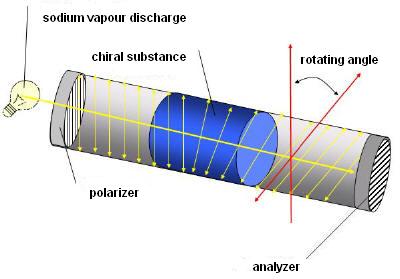|
Polarimeters
The
polarimeters of PCE are measurement devices in the field of photoelasticity to
determine the mechanical stress in transparent solid bodies. The polarimetry is
a method to determine the purity and concentration of optical active substances, e.g. glucose,
fructose, saccharine etc. in the sugar industry, creamery industry, wine
industry, beverage industry, fruit industry, as well as for the analysis of
additives in food, in medicine for the analysis of the glucose and albumin concentration
in urine, in the cosmetics industry to determine the percentage of chiral
essential oils and fragrances. In order to determine the rotating direction of
chiral substances via a polarimeter, the change in the angle of linear polarized
light as it passes through the sample of a chemical substance, leads to its
determination. These optical active substances are said to be birefringent. The
birefringence also correlates with temperature and frequency. It is often
measured at a wavelength of 589 nm (sodium-d-line), and at other wavelengths as
well. Due to its correlation with the temperature, it is often measured at a fix
temperature of 20 °C, 22 °C or 25 °C. If you don't find the
polarimeters you are looking for, please contact us and we will help you find the best solution to suit your
requirements by calling our offices on:  UK customers +44(0) 23 809 870 30 / UK customers +44(0) 23 809 870 30 /  US customers (561) 320-9162 and our technical staff will advise you regarding our
measuring instruments. Our engineers and technicians will be happy to help you with the
polarimeters, and of course, with the other products in the field of regulation and control, and
scales and
balances. US customers (561) 320-9162 and our technical staff will advise you regarding our
measuring instruments. Our engineers and technicians will be happy to help you with the
polarimeters, and of course, with the other products in the field of regulation and control, and
scales and
balances.
Here you can see polarimeters from these companies:

You can view the technical specifications for our
polarimeters at the following links:
|
|
Principle of the
polarimeters
Polarimeters mostly consist of two Nicol prisms. The fixed polarizor
polarizes the light coming from a light source (sodium vapour lamp) linearly.
The movable analyzor then helps determining the angle of the polarized
plane. If both prisms are in a 90° angle towards each other, no light can
pass through, so that a dark plane is observed. As soon as a sample of a
substance is applied in-between the two filters, their birefringence
causes an alternation of the light's angle and the spot appears a little
brighter to the observer. This brightening depends on the merit of the
rotation, which is then measured. The rotation angle α is
proportional to the film thickness l of the sample and its concentration
c. The proportionality factor or the specific rotation [α] depends on
the relevant substance, its temperature and wave length.
The formula for these correlations was developed by the french physicist
Jean B. Biot and is called Biot law:

c
= concentration in g/cm³
L = length of the tube in mm (corresponding to film thickness of the
sample)
[α]
= specific rotation (depending on temperature and wave lengths)
a = measured rotation-angel in °

|
Due
to two sequenced polarizers - the second one is called
analyzer - the following effects can be observed:
|
-
Analyzer
is placed in same angle as polarizer: light can transmit and the
polarization plane is preserved.
-
Analyzer
is in a 90° angle to polarizer: light can not pass through, the
field appears to be dark.
-
Polarizer
and analyzer placed in a 90 ° angle again, a substance is
applied, which changes the light polarization plane (so called
optical active substance) due to its birefringence, so that the
electronic field vector is rotated into a certain angle. The
analyzer must be further rotated, in order to reach the dark
spot again. The merit of this rotation is a characteristic
constant (rotating angle), which is used for the analysis of the
substance, in order to determine it, and its purity and
concentration.
|
|
Nowadays
there are many known optical active substances (either natural or
synthesized) that are able to rotate the light polarization level.
Important examples are:
|
- Sugar (saccharine)
- Some natural crystals, such as
quartz, calc spar CaCO3, cinnabar, sodium chlorate
- Liquid crystals for displays
- Many chemical solutions that are
chiral (i.e. they have two "mirror"-enantiomers) and
play an important role in areas of medicine and food, e.g.
ascorbic acid (vitamin C), Citalopram (anti-depressives)
|
Example:
26 g saccharine solved in pure water with a volume of 100 cm³ has at
standard pressure (1013 HPa) and 589.44 nm in a sample tube of 200 mm an
optical rotation angle of 34.626° ang ±0.001°. This solution is called
a standard sugar solution, and is used to calibrate and validate polymeric
methods and devices. It is the reference point of the international sugar
scale (ISS) defined by the ICUMSA. The rotation of 34.626° ang correlates
with a concentration of 26g/l saccharine. The ISS is a linear scale, i.e.
a rotation of 17.313° ang correlates with 13 g/100cm³
saccharine.
Sugar solutions are not
very stable and must be re-prepared on a regular basis. A much more
reliable method to test a polarimeter is the one with quartz. In 1811 the
french physicist F. Arago discovered its polarizing characteristics and
the optical activity of natural quartz. The rotation angle depends on the
layer thickness and the wave length of the used light. And it is almost
identical with the rotation angle of a saccharine solution. Quartz control
plates are nowadays used as inert standards for the calibration of the
polarimeters. |
|
If you wish to see or print a selection of
polarimeters from our catalogue, click the PDF symbol

|
|



